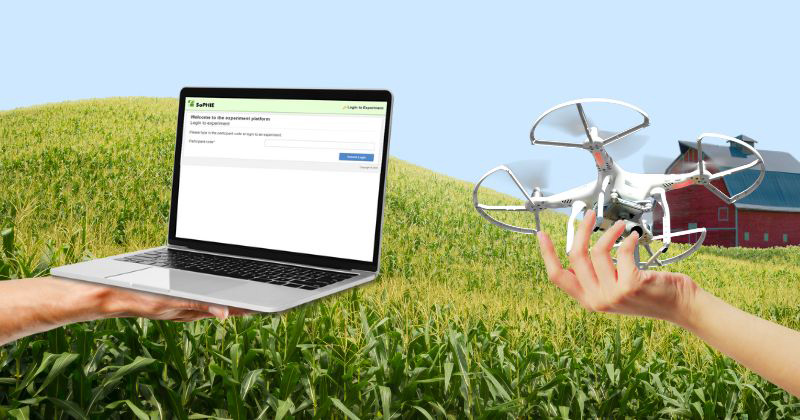Agricultural policy making | UDaily
Agricultural policy making | UDaily UDaily


How Stakeholder Participation in Economic Experiments Can Inform Agricultural Policy

A few years ago, Kent Messer, the S. Hallock du Pont Professor of Applied Economics at the University of Delaware, conducted research to determine how to motivate farmers to take action against climate change. Contrary to conventional wisdom, the study found that directly referencing climate change and greenhouse gases did not discourage farmers from implementing conservation measures. This finding, along with the collaboration of scientists from the U.S. Department of Agriculture (USDA) and other researchers, was published in a prominent scientific journal.
Building on this research, Messer and Leah Palm-Forster, a faculty member at the University of Delaware, recently published a paper in the journal Applied Economics Perspectives and Policy. The paper focuses on stakeholder participation in economic experiments for agricultural policymaking and offers 12 recommendations for researchers in this field. By involving stakeholders such as farmers, government policymakers, and advisors in the design process of these experiments, the researchers believe that their findings will be more readily accepted and can contribute to meaningful agricultural policy.
Featured Research
The paper consolidates six research projects and provides an overview of the researchers’ experiences with economic experiments. It highlights lessons learned and offers recommendations for future studies in this area.
Messer’s study involved mailing letters to agricultural producers across the U.S., encouraging them to adopt environmentally-friendly farming practices. Some letters mentioned greenhouse gas emissions and climate change, while others did not. Palm-Forster collaborated with Tongzhe Li, a professor at the University of Guelph, on a field experiment in Ontario, Canada, which explored strategies for incentivizing farmers to use environmentally-friendly agricultural management practices.
The researchers emphasize the value of stakeholder-driven research and the importance of collaboration with stakeholders in designing studies that inform evidence-based programs supporting agriculture and the environment.
Advantages and Disadvantages of Stakeholder Involvement
The researchers identified several advantages of involving stakeholders in the design process of economic experiments. Stakeholders provide valuable knowledge that enhances the realism and relevance of the study, leading to more meaningful policy recommendations. However, building relationships with stakeholders can be time-consuming, which may pose challenges for researchers with limited budgets and tight schedules.
Despite these challenges, Palm-Forster emphasizes the value of collaboration with stakeholders in research design. She believes that working with stakeholders ensures that the research questions are relevant and policy-driven, ultimately leading to evidence-based recommendations for improving agri-environmental outcomes.
Messer highlights the challenges of collaborating with government agencies and emphasizes the need for buy-in from multiple stakeholders. He suggests that researchers should carefully prepare, establish clear goals, and secure sufficient funding for their studies.
Importance of Economic Experiments
Messer emphasizes the importance of conducting economic experiments to address conservation and climate change challenges. He believes that academia and government should frequently engage in discussions to ensure that taxpayer money is spent effectively on research that extends knowledge in these areas.
Funding
Messer’s research was funded by the USDA National Institute of Food and Agriculture and USDA Economic Research Service. Palm-Forster and Li received funding from various sources including the Weston Family Foundation, the Ontario Ministry of Agriculture, Food and Rural Affairs, the Natural Sciences and Engineering Research Council of Canada, and the Agriculture and Agri-Food Canada.
SDGs, Targets, and Indicators Analysis
1. Which SDGs are addressed or connected to the issues highlighted in the article?
- SDG 2: Zero Hunger
- SDG 13: Climate Action
- SDG 15: Life on Land
The issues highlighted in the article are related to agriculture, climate change, and environmental conservation, which are connected to SDG 2, SDG 13, and SDG 15.
2. What specific targets under those SDGs can be identified based on the article’s content?
- SDG 2.4: By 2030, ensure sustainable food production systems and implement resilient agricultural practices that increase productivity and production, that help maintain ecosystems, that strengthen capacity for adaptation to climate change, extreme weather, drought, flooding and other disasters, and that progressively improve land and soil quality.
- SDG 13.2: Integrate climate change measures into national policies, strategies and planning.
- SDG 15.5: Take urgent and significant action to reduce degradation of natural habitats, halt the loss of biodiversity and, by 2020, protect and prevent the extinction of threatened species.
The article discusses the need for sustainable agricultural practices, integration of climate change measures into agricultural policies, and the importance of protecting natural habitats and biodiversity.
3. Are there any indicators mentioned or implied in the article that can be used to measure progress towards the identified targets?
- Indicator for SDG 2.4: Adoption of sustainable agricultural practices, increase in productivity, improvement in land and soil quality.
- Indicator for SDG 13.2: Integration of climate change measures in national agricultural policies.
- Indicator for SDG 15.5: Reduction in degradation of natural habitats, conservation of biodiversity.
The article does not explicitly mention specific indicators, but the progress towards the identified targets can be measured by monitoring the adoption of sustainable agricultural practices, improvement in land and soil quality, integration of climate change measures in agricultural policies, and the conservation of natural habitats and biodiversity.
Table: SDGs, Targets, and Indicators
| SDGs | Targets | Indicators |
|---|---|---|
| SDG 2: Zero Hunger | Target 2.4: Ensure sustainable food production systems and implement resilient agricultural practices | Adoption of sustainable agricultural practices, increase in productivity, improvement in land and soil quality |
| SDG 13: Climate Action | Target 13.2: Integrate climate change measures into national policies, strategies, and planning | Integration of climate change measures in national agricultural policies |
| SDG 15: Life on Land | Target 15.5: Take urgent and significant action to reduce degradation of natural habitats and protect biodiversity | Reduction in degradation of natural habitats, conservation of biodiversity |
Behold! This splendid article springs forth from the wellspring of knowledge, shaped by a wondrous proprietary AI technology that delved into a vast ocean of data, illuminating the path towards the Sustainable Development Goals. Remember that all rights are reserved by SDG Investors LLC, empowering us to champion progress together.
Source: udel.edu

Join us, as fellow seekers of change, on a transformative journey at https://sdgtalks.ai/welcome, where you can become a member and actively contribute to shaping a brighter future.







